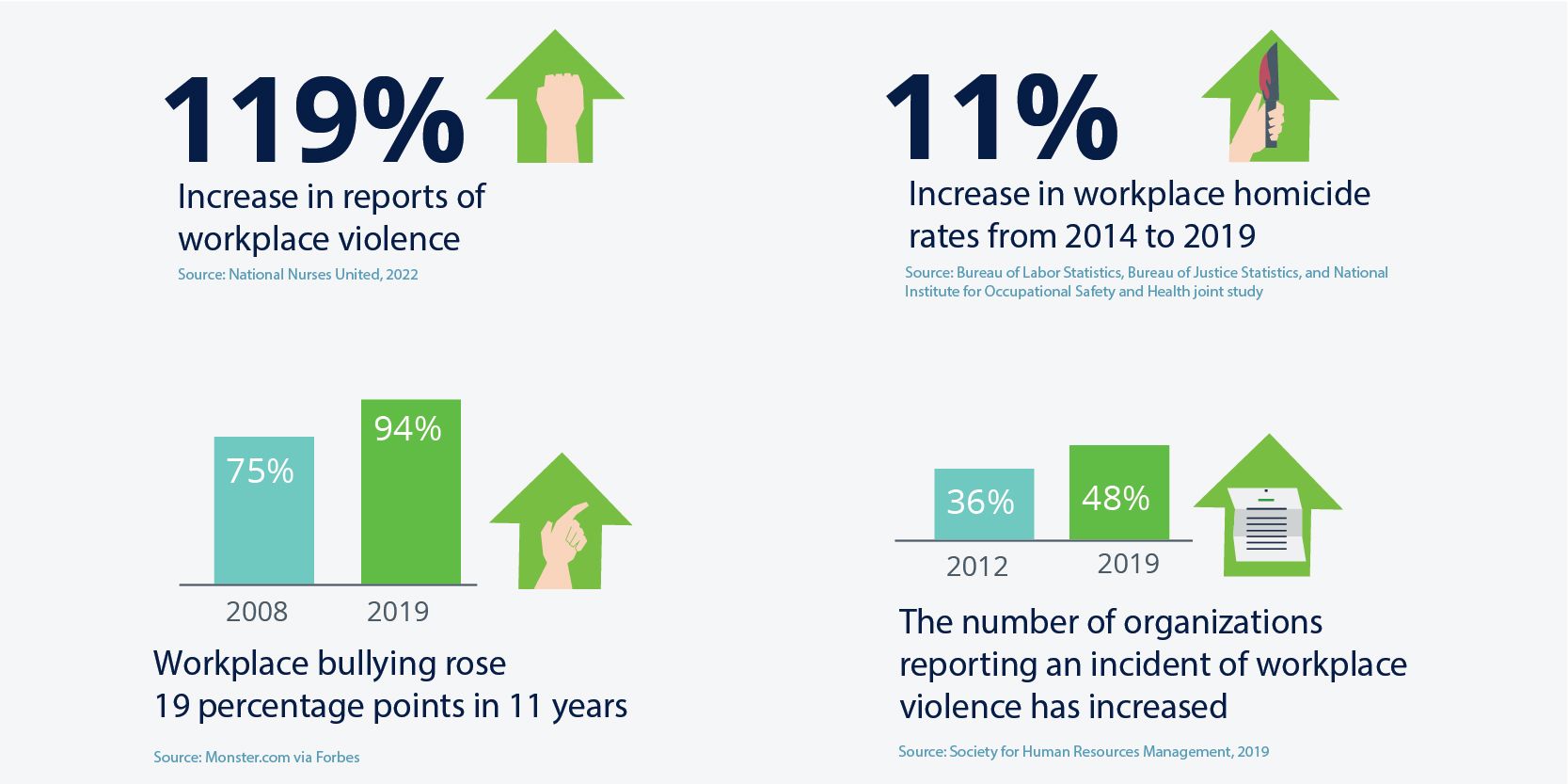Blog
Workplace Violence & Workers' Compensation: Are You Prepared?
Learn about industries with the highest rates of workplace violence, the type of claims that are and aren’t covered by workers’ comp, and other types of risks employers face.
Although many people think it will never happen at their company, workplace violence can happen anytime and anywhere—and it's on the rise.
For employees, workplace violence can impact their mental and physical health, productivity, and morale. For companies, it means increased exposure to workers’ compensation claims. To control this risk, Human Resources managers, supervisors, and risk managers need to understand how to prevent workplace violence in the first place, and how to mitigate the impact should an incident occur.
What Constitutes Workplace Violence and Which Industries Are Most Affected?
According to the Centers for Disease Control and Prevention (CDC), workplace violence:
- Is an act or threat of violence
- Ranges from verbal abuse to physical assaults
- Is directed toward people at work or on duty
- Causes harm ranging from psychological issues to physical injury to death
Types of workplace violence can include bullying, assault, angry outbursts, robbery, and mass shootings.
Industries with more frequent contact with the public have the highest rates of workplace violence. These include community and social services, law enforcement, transportation and delivery, and education and training.
Unfortunately, several studies show workplace violence is on the rise.

What Types of Workplace Violence Claims Does Workers’ Compensation Cover?
Employees who are either injured in an incident or suffer psychological trauma from witnessing one are entitled to seek medical treatment and disability benefits through workers’ compensation. Dependents of employees who are fatally injured in such incidents are entitled to seek death benefits.
Physical Injuries
Many types of physical injuries are potentially covered, including:
- Falls from being pushed
- Abrasions, contusions, lacerations, and fractures from being attacked
- Gunshot wounds
Psychological Injuries
An employee doesn’t have to suffer a physical injury to file a workers’ compensation claim. Many times, workplace violence gives rise to psychological injury claims , which may be covered depending on the state jurisdiction, even if an employee was not the intended victim. Such employees may be covered under workers’ compensation if they:
- Witness a violent event between others at work
- Experience threats of violence (even if no physical violence takes place)
- Experience a physiological reaction like a heart attack caused by the psychological stress of receiving threats or witnessing violence
In addition to employees, innocent bystanders who are injured or experience emotional distress would likely be covered.
What Types of Workplace Violence Claims Aren’t Covered by Workers’ Compensation?
Regardless of the “no fault” premise in workers’ compensation, not all workplace violence injuries are covered under the law. It doesn't matter who triggered the incident, whether it's a coworker, manager, customer, or third party. What does matter is the employee must be working in the course and scope of their occupation to have a successful claim.
The following situations would likely not be covered by workers’ compensation:
- An employee who is socializing at will after hours or off premises while being victimized or witnessing an attack, even if it’s by a coworker
- An employee who is the “initial physical aggressor” and suffers injuries from the altercation
- An employee who is attacked but is involved in a criminal relationship with the attacker
- Two employees fighting over a personal matter unrelated to employment, like an argument between spouses who also happen to be coworkers or a fight between coworkers over an affair
Other Risks of Workplace Violence to Employers
In addition to workers’ compensation claims, employers are at risk for civil litigation such as serious and willful misconduct claims and other lawsuits alleging unsafe working environments or conditions.
A recent example making headlines involves a Virginia teacher who was shot and seriously wounded by her 6-year-old student. The teacher filed a lawsuit seeking $40 million in damages from the school district, accusing them of gross negligence and of ignoring multiple warnings the day of the shooting that the boy was armed and in a “violent mood.”
This case is still pending, but the school district’s defense team will likely argue that workers’ compensation is the employee’s “exclusive remedy”—a workers' compensation provision that prohibits injured employees from suing their employer if they are receiving WC benefits. Although the school district may prevail in arguing the exclusive remedy defense, the district has likely spent hundreds of thousands of dollars in legal fees defending the negligence allegations.
Attitudes are shifting about the WC system’s exclusive remedy provision. Many legal experts now believe the provision can't be used as a means of avoiding implementing safety practices.
Sexual harassment and assault claims are unique. Employers should be aware that these and other types of workplace violence incidents may be covered under other policies, such as an employment practices liability (EPL) policy.
A workplace violence endorsement to the EPL policy providing limited protection is another possibility. Because these situations are highly fact-, coverage-, and jurisdictionally based, employers should consider consulting their broker and labor counsel to discuss considerations.
Preventing Workplace Violence Step 1: Identify the Red Flags
Preventing workplace violence claims starts with an understanding of the cause of workplace violence. Anger, especially unhealthy expressions of anger and other mental health issues, is often at the root of acts of violence, including at work. Experts believe that the primary causes of workplace violence are specifically related to individuals facing employment and/or outside stressors.
Employment stressors include:
- Company mergers
- Restructuring
- Performance issues
- Termination or layoffs
Outside stressors include:
- Divorce
- Death
- Caring for the health of a family member or loved one
- Financial loss
These stressors can greatly affect an employee’s wellbeing.
In combination with these, social isolation, such as that experienced by many during the pandemic, can exacerbate an employee’s stress level. The more stressors and collective losses individuals experience at once, the more likely a mental health issue and the potential for violence may arise.
Recognizing these signs as red flags can help stop workplace violence and injury claims in their tracks.
Preventing Workplace Violence Step 2: Tend to Mental Health
Supporting the mental health of employees helps treat the root cause of workplace violence.
The tide is turning, and most HR professionals believe mental health is a responsibility shared by employees and employers.
Steps employers can take to support the mental health of their employees include:
- Reaching out to individuals and teams who may be in distress or at risk. This can go a long way toward developing trust, respect, and connection, as well as making employees feel less alone and more supported.
- Providing useful tools like wellness resources, Employee Assistance Programs (EAPs), mental health apps, or financial coaching.
- Mentoring and Employee Resource Groups (ERG) may help prevent anxiety and develop team building during restructuring or job changes.
- Assisting employees with finding other employment through job placement services and referrals could defuse tensions from being let go.
At a minimum, employers should offer supervisors and managers communication and conflict resolution skills training. De-escalation training can also be very helpful when it comes to handling performance reviews and disciplinary actions with difficult employees. Empathy can go a long way in deescalating intense emotions.
Preventing Workplace Violence Step 3: Make a Violence and Safety Awareness Plan
Developing an employer violence and safety awareness plan can help prevent violence and make it less likely to escalate.
Employers should outline the steps to take in the unfortunate event that a workplace violence incident occurs. This plan should be shared with employees, who should also be trained in the fundamentals. To get started, consult your broker or carrier loss control representative. The Occupational Safety and Health Administration (OSHA) also provides helpful resources.
What to Do When Workplace Violence Occurs
First and foremost, if an employee or employees are injured during a violent episode, seek prompt medical treatment when necessary. The top priority should always be to take care of your employees.
Remember that in the absence of a physical injury, psychological injuries are possible and common, even if the employee was only a witness. One way to reduce the number and severity of psychological trauma claims is to offer affected employees timely counseling by a third-party expert.
If an injury is caused by a third party like a customer or contractor, make sure to obtain as much information as possible about the party and inform your insurance carrier and broker. In this case, subrogation is a method of recovering costs paid in the workers’ compensation claim.
All injuries in the workplace have unique circumstances, and those caused by violent incidents are no exception. Coverage isn’t always straightforward, and there are often complex legal and jurisdictional issues at play. Before placing your carrier on notice, it’s always a good idea to discuss the situation with your broker to determine the best strategy.
Lead with Empathy
The best way to avoid workers’ compensation claims related to workplace violence is to take steps to prevent it in the first place. Learn the red flags, provide mental health tools, make a violence and safety awareness plan, and lead with empathy. You will proactively address mental health issues and reduce the likelihood of violence while also improving morale. The result is fewer claims and a more engaged and productive workforce.
If you would like more information about this topic, insurance services, workers’ compensation, or employee benefits, contact your Woodruff Sawyer service team.
Author
Table of Contents












